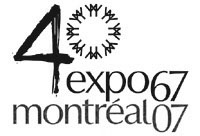August
4
|
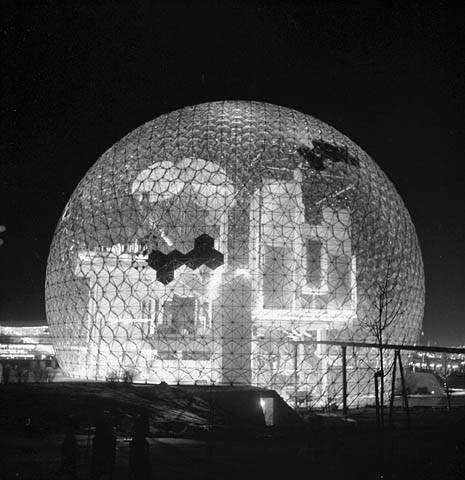
Photo credit:
© the National Archives of
Canada
|
THE USA PAVILION:
BUCKMINSTER FULLER'S
"GEODESIC DOME" WAS A BIG ATTRACTION
|
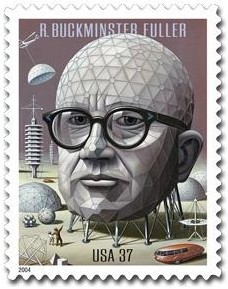
USA Postal Service: The R.
Buckminsiter Fuller Commemorative Stamp was issued on July 12, 2004
based on the front cover edition of Time Magazine, January 10,
1964. |
|
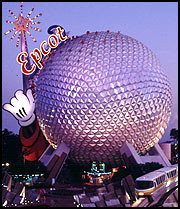
Spaceship Earth at Epcot
Centre, Disney World, Florida.
"EPCOT...will take its cue
from the new ideas and new technologies that are now emerging from
the creative centers of American industry. It will be a community of
tomorrow that will never be completed, but will always be
introducing and testing and demonstrating new materials and systems.
And EPCOT will always be a showcase to the world for the ingenuity
and imagination of American free enterprise." -- Walt Disney. Thus,
the acronym for EPCOT stands for: "Experimental Prototype Community
of Tomorrow."
|
From 1947 "the geodesic dome dominated
[Buckminster] Fuller's life and career," writes the U.S. Postal Service.
"Lightweight, cost-effective and easy to assemble, geodesic domes enclose
more space without intrusive supporting columns than any other structure,
efficiently distribute stress, and can withstand extremely harsh
conditions. Based on Fuller's "synergetic geometry," his lifelong
exploration of nature's principles of design, the geodesic dome was the
result of his revolutionary discoveries about balancing compression and
tension forces in building. Fuller applied for a patent for the geodesic
dome in 1951 and received it in 1954."
At Expo 67, Buckminster Fuller's geodesic dome
was one of his finest efforts. It is "as high as a 20-storey building
[which] soon became "the" focal point on the Île Sainte-Hélèn site,"
writes Biosphère, Environment Museum . "In the space of six months it was
visited by 5.3 million people, making it the busiest pavilion at Expo
'67. Its six inner floors on the theme "Creative America", contained
several hundreds artifacts and works of art bearing witness to American
genius, and some of the space rockets actually used in the Apollo
program. However, everyone agreed that the highlight of the
presentation was the building itself. The huge sphere, with a diameter of
more than 80 metres, was imposing from the outside but discreet from the
inside. At night, it was transformed into a sparkling jewel that dominated
the landscape. In 1967 Buckminster Fuller celebrated his 50th wedding
anniversary, and dedicated the dome to his wife Anne when they visited the
site in April of that year."
In 1982, inspired by the work of Buckminster
Fuller, "Spaceship Earth" was built at Epcot in Disney World, Florida. The
full, slightly uneven circle, is not a geodesic dome whereas "a true
geodesic dome is hemispherical," writes Jackie Craven of About.com:
Architecture. "Spaceship Earth encloses some 2,200,000 cubic feet of
space inside a globe which is 165 feet in diameter. The outer surface is
composed of 954 triangular panels made of a polyethylene core sandwiched
between two anodized aluminum plates. These panels are not all the same
size and shape." The aluminum is "smother than glass" writes Richard
R. Beard in his book Walt Disney's Epcot: Creating the New World of
Tomorrow. "[T]he globe's facet reflect diffuse images as varied as its
surroundings: by day, Spaceship Earth mirrors the sky, the land, the
patterns made by Epcot Centre's structures, walkways, and visitors; by
night, it glints with the sparkle and illumination not only of World
Showcase across the lagoon but also of the galaxies, the stars, the
planets it emulates."
Spaceship Earth is even environmentally
friendly: "And if, on occasion, it reflects only a torrential rain, rest
assured that the water cascading down the giant sphere will not drench the
unsuspecting pedestrian below. The water will be collected within the
globe itself, and be used to replenish the wells which in turn replenish
the lagoon. Such is the way of Epcot Centre," writes Beard.
Buckminster Fuller died in Los Angeles on July
1, 1983.
Important links:
Biosphère,
Environment Museum Canada
Spaceship
Earth and Buckminster Fuller's Geodesic Domes - by Jackie
Craven
The
United States Commemorative Postage Stamp to Honor R. Buckminster Fuller,
The Man (and the Mind) Behind the Geodesic Dome
|
|
From the Montréal Gazette, Aug.
4/07: "Expo 67's sculptors, then and now"
"Perhaps the biggest stand-out in
the smattering of Montreal events commemorating the 40th anniversary of
Montreal's year of good feeling is the modest exhibit now on view at
Stewart Hall in Pointe Claire," writes freelance journalist Henry Lehmann
in his excellent report. "Succinctly titled Expo 67 Revisited, this
informative exhibit focuses both on the art actually produced for the Expo
site and on recent art by the same sculptors. The artists, Anne Kahane,
Robert Roussil, Yves Trudeau, Mario Merola, David Sorensen and Armand
Vaillancourt, represent a cross-section of Montreal's avant-garde of the
1960s, and all are still active."
To read the complete article,
please click: "Expo
67's sculptors, then and now."
-----------------------------------------------------------
The following films are being
presented by Québecois Cinéclub in Montréal...
Images with a future
The National Film Board and the
Labyrinth pavilion in Expo 67
From May 4 at September 2
Prolongation until November
4
Luce-Guilbeault Hearth
Free entry
This new temporary film presents
photographs documenting the fantastic Labyrinth pavilion.
Based
around a score of images, the film recalls the design and the setting used
at Labyrinth as seen by more than one million spectators during Expo 67.
With the concept "See large and show imagination!" of
the exposition, the
National Film Board (NFB) answered by an allegorical architecture of the
labyrinth of Maze, conceived on five stages, using cinematographic
techniques, examples of what would announce being the future of the visual
language.
This film presents an occasion to plunge in the emulation
which was Expo 67 and to include/understand, more particularly,
what Labyrinth gave us a chance to see: a control of the man on
itself.
The film is being presented by the NFB in collaboration
with the Québécois Cinéclub.
"Man and His World" Film Contest
A
selection of 20 short films and an exposure of documents of files
From July 12 at August
26
Norman-McLaren Room
Free entry
Launched in 1966 in Montreal and New
York by the organizers of the 8th international Film Festival of Montréal,
this competition invited scenario writers from around the world to carry
out a 50 second old film relating to the topic of the
Expo 67. In order to underline the 40th birthday of Expo 67, this
exhibition presents 20 short films that were made for the "Man and His
World" contest.
-----------------------------------------------------------
|
|
July 21
The Sun Life Carillon was known as
"The Voice of Expo 67"
| For the 40th
Anniversary Edition of Expo 67, we examine the past and current
history of the Sun Life Carillon...
THE VOICE OF EXPO 67
Installed by the Sun Life Assurance
Company of Canada on Parc Hélène for Expo 67, the carillon sounds
came from 671 bells "from the 96 foot top of La Tour de Lévis on the
153 foot high summit of Mont Boullé" wrote the Expo 67 Official
Guide. The summit was a "miniature mountain in the centre of
the park which bears Madame de Champlain's maiden name," it noted in
the write-up.
Carillonneur Lucien Hétu was given the
honour of playing the carillon. In "Wondrous Fair", an article by
the Canadian magazine, it was reported Hétu played concerts and
classical tunes in the afternoon and evening during Expo 67.
For visitors to Expo, those must of been
the sweetest and most gentle sounds to be heard at the fair.
Today, carillon concerts are heard daily
at 5 p.m. at the Sun Life Building in Montréal. By arrangement, the
carillon can also be played for special occasions and festive
seasons.
Below this introduction, Jocelyne
Michaluck, Coordinator - Conference Centre, Sun Life Building,
graciously provided some of the fascinating background material
about the carillon. The audio clip and photograph of Hétu was
graciously provided by Andre Fiset of Laval which helps to re-create
those wonderful carillon sounds through a cover version of "Hey
Friend, Say Friend', Expo 67's official theme song.
The Sun Life carillon is part of
Montréal's proud and rich
history. |
|

|
|

Click the "On Air" image
and listen to an instrumental version of "Hey Friend, Say Friend" as
performed by Lucien Hétu on the Sun Life
Carillon. |
The Carillon
Montréalers
and visitors to Montréal enjoy the sound of bell music in Dominion Square.
The bells belong to the Sun Life Carillon which plays concerts throughout
the year. Following its role as the Voice of Expo 67, the Carillon was
installed in the Sun Life Building (shortly after Expo 67).
|
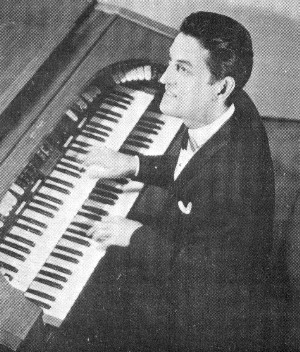
Carillonneur Lucien
Hétu
|
This carillon, one of the largest in the world,
can reproduce the sounds of 671 cast bells. The lowest note is equivalent
to a 22-ton cast bell, which is the lowest tone even produced in a bell
system.
As an instrument, the carillon was developed in the 13th
century in four-bell form, mainly in the Netherlands and Belgium. Over
succeeding centuries it evolved as an instrument of great significance.
The electro-mechanical principle upon which the Sun Life Carillon is
based, was developed only recently and gives the instrument much greater
capacity, versatility and range. This carillon was built by Schulmerich
Carillons Inc., of Sellersville, Pa.
How the carillon is
played
The Sun Life Carillon is played on a console,
resembling a large organ, placed in a balcony overlooking the ground floor
banking hall.
It may be played by a carillonneur or
automatically.
When the carillonneur sits down at the console, he
has the equivalent of 1,500 tons of cast bells at his command. Instead of
heavy bells, the Sun Life Carillon is made up of small tuned bars of bell
metal. When the musician touches a key on the console, a signal is sent to
the equipment housed in the basement of the building, and a small steel
hammer strikes the appropriate metal bar. The impact of the hammer causes
the bar th vibrate, though the sound produced is only a faint
"ping".
The vibrations are fed by an electrostatic pickup unit into
a device that changes these physical sound vibrations into electrical
impulses. The machine that performs this feat is called a "vibrating-tone
generator".
Once the original vibrations have become a series of
electrical impulses, they are then passed on to an amplifier. Here the
electrical impulses are amplified hundreds of thousands of times, and then
fed to stentors (speakers) which convert the electrical impulses into
actual bell music. Power amplification of 3,600 watts of audio power is
provided to the stentors, which have a frequency range of 50 to 20,000
cycles per second.
The Sun Life Carillon was temporarily
silenced by the 1998 ice storm
|
The winter of 1998 would be
remembered for its famous "ice storm" that severely hit both
Montréal and Ottawa. Rain had fallen continuously for nearly a week,
causing the rain to solidify into ice. The build-up of the ice was
so great (about as thick as a "hot-dog bun") on the outdoor
electrical power lines, that the weight of the ice snapped
electrical cables and toppled some of those steel towers that
supported them. Unfortunately, the ice storm also impacted on the
Sun Life Carillon. The following comments were culled directly
from the Sun Life Building "What's New? Tenant Newsletter", Spring
2003, Vol. 1, No. 1
edition... |
We are pleased to announce the refurbishment of
the Sun Life Carillon. This wonderful 671-bell carillon originally
known as the voice of Expo 67. It was installed in the Sun Life
Building where it remained in operation until the ice storm of '98 forced
it into silence.
The Sun Life team worked extremely hard to
bring back the sound of music. We are pleased to announce, as
partner of the Montréal High Lights Festival and the sponsor of the "Sun
Life Financial Performing Arts" that Thursday, February 13, 2003 marked
the return of the sound from the past. Once again a musical storm
hit the streets of downtown Montréal. For the duration of the
festival, the famous bells greeted after-work crowds from 5:00 p.m. to
5:10 p.m., Monday to Friday.
About the carilloneur Lucien
Hétu
from The
Canadian Encyclopedia Historica...
Lucien Hétu. Organist, songwriter, singer, b
Ancienne-Lorette, near Quebec City, 8 Apr 1926, d Montréal 10 Jan 1990. He
first studied organ 1949-51 with Georges Lindsay. In 1952 as a singer he
won the grand prize of the CBC radio competition 'Les Talents de
chez-nous.' He studied voice 1952-3 with Paul DuBois and organ 1954-5 with
Germaine Janelle. In 1953 he sang and was co-host on the CKAC radio
program 'Sans tambour ni trompette.' As a songwriter he took part in the
CBC French network's 'Concours de la chanson canadienne'; his songs 'Parc
Lafontaine,' 'Compagnon de route,' 'La Madone,' 'Pourtant je l'aime,' and
'Vague à l'âme' made an impression at this competition. He then became
known chiefly as an organist and in this capacity he directed the opening
of CFTM-TV in 1961. Some of the songs from his 1968 recital with his son
Daniel at the Comédie-Canadienne were released on an RCA LP (Gala
CGPS-295). Father and son also toured Canada that year as singer and
pianist, and in 1969 they appeared at the PDA.
The Montréal Festival du disque awarded Hétu
two trophies in 1968, one as a performer and another for successful sales
of his records. In 1970 he received a gold record for the highest sales of
the year. He appeared in Paris in 1965, Switzerland in 1968, and Japan in
1970. He made some 30 LPs for RCA Victor, as well as some for Visa. Most
of his recordings are of dance music or music for festive occasions. In
1978 for Reader's Digest he produced a set of six LPs entitled Les Mille
Visages de l'orgue (RCA), in which he performed 72 old and new hit tunes.
He also recorded several of Marc Gélinas's hits for the LPs La Ronde
(Harmonie HF-90140) and Marc Gélinas: ses chansons interprétées à l'orgue
(Jupiter JPL-11009).
Bibilograhy used for the Sun Life
Carillon:
1. The Canadian Encyclopedia Historica, Encyclopedia
of Music in Canada, Lucien Hétu, written by Denis Allaire, Denise
Ménard, Suzanne Thomas.
2. Sun Life Building, "What's
New? Tenant Newsletter", Spring 2003, Vol. 1, No. 1
edition.
3. Jocelyne Michaluck, Coordinator -
Conference Centre, Sun Life Building, for e-mailing the basic history
about the carillon.
4. The Canadian Magazine: "Wondrous Fair", Vol.
3, No. 24, June 17, 1967. Distributed by Southstar Publishers Limited,
Toronto, Ontario.
5. The Canadian Corporation for the 1967 World
Exhibition, "Expo 67 Official Guide".
----------------------------------------------------------- |
|

|
The Québec Pavilion was filled with
Electronic Music
Described as "electroacoustic work",
Gilles Tremblay's "Centre Elan" was the music that was heard at the Québec
Pavilion. "The pavilion's exhibits focused on urbanization,
industrialization, business and education in the province while also
presenting natural resources, particularly forestry and water as growth
industries," writes the Canadian Music Centre. "It was the
relationship between modern man and his environment that informed
Tremblay's soundscape, which featured recordings of sounds collected from
across the province."
Time Magazine described it as "Music
on the Move. At the Québec Pavilion, for example, a series of almost blank
abstractions -- freestanding blocks representing water, forests, industry
-- is bathed in an electronic score, by Canadian Broadcasting Corporation
Staff Composer Gilles Tremblay, in which lab-produced whir, twitter and
roar complement the visual suggestions. High overhead the individual
sound tracks collide and coalesce into a contrapuntal aural landscape."
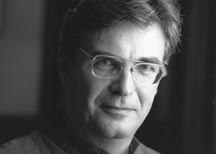
Composer, Gilles
Tremblay |
Gilles Tremblay's musical background
in how he learned music (i.e. composer, pianist, ondes Martenotplayer,
etc.) is an extensive one, but one of interesting facts that emerged from
his past was that "he made the acquaintance of Karlheinze Stockhausen in
Darmstadt in the late 1950s" writes the Living Composers
Project. Stockhausen, who is acknowledged as the first pioneer
of electronic music, likely had some influence on Tremblay's work
(as did Boulez, Boucourechliev, Ferrari and Xenakis) if one listens
closely to the
short audio presentation of "Centre Elan" at the CMC
website.
The "Centre Eland" soundtrack at the
Québec Pavilion earned him the Prix de musique Calixa-Lavallée award in
1968. It is "awarded by a jury of the St-Jean-Baptiste Society of Montréal
to a resident of Québec whose accomplishment and distinction in the field
of music have served or are serving the higher interests of the people of
Québec and abroad," writes the Canadian Encyclopedia.com.
|
-----------------------------------------------------------
July 12
Abbotsford British Columbia
remembers Expo 67!
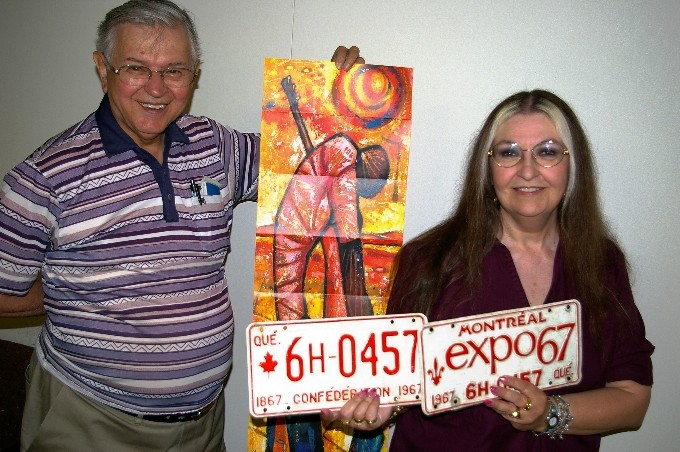
Photo credit © Rick Rake, 2007.
Used with permission.
Hi John,
We had an
interesting session of sharing stories, examining souvenirs and listening
to University College of the Fraser Valley Canadian history professor, Dr.
Molly Ungar outline the story of Expo 67 in her talk at the MSA Museum
Annex in Abbotsford, British Columbia tonight.
I took a picture of
Dr. Ungar (woman on the right with the 1967 Quebec licence plates) and a
member of the audience (an Abbotsford man who lived in Montréal and
attended Expo) Roger Caza holding up an Alexander Cooper poster from the
Jamaica Pavilion at Expo.
Ungar explained how Expo came to be,
showcased the culture and fashion of the time and how the event
contributed to the feeling of Canadian nationalism and pride. She played
the CA-NA-DA song and showed many compelling slides from the centennial
spectacle.
Other souvenirs circulated among the crowd were adult
and child Expo passports, Expo souvenir coins, postcards, 5-cent stamps,
Dow beer bottle caps, site posters, a record from the Trinidad pavilion’s
touring steel band, pavilion pamphlets (from Russian, Western Provinces,
India, Britain and India pavilions), Expo entertainment booklet and of
course the official Expo guide.
It was a great time and a neat
Western Canada style tribute to one of Canada’s most memorable
celebrations.
Cheers,
Rick Rake
Abbotsford
Expo 67 in Montréal website
footnote: Special thanks to Rick Rake for this excellent report. Rick is
editor for the Abbotsford News.
-----------------------------------------------------------
July 10
World at our door
The amazing architecture of Expo 67 was just part of its
many wonders
By PAT MACADAM, columnist for the Ottawa Sun
In
the beginning, Expo 67 was about as popular as a case of lockjaw at a corn
boil.
Politicians, press and the public pounced on the Montréal
World Fair without quarter.
Why are they building new islands in
the St. Lawrence River when there is so much open land on the island of
Montréal?
It will never open on time!
Nobody will come!
The crepe hangers hadn't heard of les durs -- "the tough guys".
Smooth as silk former diplomat, Pierre Dupuy, was commissioner
general. He sold the dream.
Former president of Foundation Canada,
Bob Shaw, was deputy commissioner general. He sold the structural steel
and the bricks and mortar.
'FIRE THE BASTARD'
Andy
Kniewasser, a former assistant deputy minister in the federal Trade and
Commerce department, was general manager. His nickname was "Fire the
Bastard."
Col. Ed Churchill was the hard driving Army engineer who
built the infrastructure. He had 1,042 days to do it. He worked with a new
tool -- "critical path" -- to prioritize functions.
Philippe de
Gaspe Beaubien was Mr. Everything and he would become "Mayor of the Fair."
Pierre deBellefeuille headed up the exhibits department.
Nathan Steinberg of the grocery family handled concessions and
licensing ("Conk and Lick").
Yves Jasmin, the urbane Ford of
Canada public relations manager, headed up Expo's PR department.
Ken Johnstone, Canada's most gifted magazine writer headed up the
news bureau and put together a stable of experienced journalists and PR
types.
These were Expo 67's shock troops.
Andy Kniewasser
called me over to his office one morning. He was well aware of my close
ties with John Diefenbaker's Opposition caucus.
"Patrick, what can
we do to get Opposition MPs behind Expo? They keep sniping at us in the
House."
I picked up Andy's phone.
"May I?"
I
dialled MP Bob Coates' office. Bob was chairman of the powerful Members'
Management and Services Committee -- a post traditionally reserved for an
opposition MP -- and he and I were long-time friends.
"Bob, I'm
sitting here with Andy Kniewasser and we wonder if you can help us? Can
you organize a bunch of MPs to come to Montréal at our expense for a site
tour and briefings?
"They should be aware that the fair was Senate
Speaker Mark Drouin's idea and Dief's Government gave it the green light
and federal funding. Doesn't it seem strange that the Tory Opposition is
now lambasting it?"
Bob agreed and the very next week a busload of
Opposition MPs -- Theo Ricard, Eldon Woolliams, Jack MacIntosh, Jack
Horner, Warner Jorgenson, Coates and others -- came to Montréal.
Pierre Dupuy, Bob Shaw and Andy Kniewasser dazzled them with their
visionary briefings. If the MPs arrived as sceptics, they left as
converts. There were no more pot shots during question period.
Expo sponsored a Press Club Ball and laid out big bucks for talent
-- Robbie Lane and the Disciples and Canada's "pet" -- singer Juliette.
Pierre Dupuy was the darling of the media. They loved his low-key,
laid-back way of parrying questions. A reporter asked him if it were true
there would be singing porpoises in the Alcan Aquarium.
"Yes!"
"What are the porpoises doing now, Mr. Dupuy?"
"They're
rehearsing."
AWASH WITH CELEBRITIES
Before and
during the fair, the site was awash with royalty and celebrities.
Ethiopian Emperor Haile Selassie was there with his small dog. The
Shah of Iran and his Empress, Queen Elizabeth II and Prince Philip, Prince
Rainier and Princess Grace, Princess Margaret and Lord Snowdon, U.S.
President Lyndon Johnson, French President Charles de Gaulle, the King of
Thailand and Prince Albert of Belgium all made appearances.
Laurence Olivier, Bing Crosby, Harry Belafonte, Maurice Chevalier,
Thelonius Monk, Marlene Dietrich, Carol Channing, Patrick McNee, Jack
Lemmon, Robert Wagner, Jackie Kennedy and Bobby Kennedy and family
rubber-necked.
Buckminster Fuller's stunning geodesic dome for the
U.S. pavilion was a hit. Sir Basil Spence, architect of Coventry
Cathedral, designed the soaring British pavilion. Moshe Safdie's "Habitat"
of 158 pre-fabricated housing units was a pathfinder in new methods of
construction.
Bell Canada's 360-degree film was spectacular and
competed with Czechoslovakia's Lanterna Magika for best visual honours.
Irish designer Sean Kenny's out-sized ride -- Gyrotron -- was
spectacular.
The 33,000-seat Autostade was designed to be portable
and was to be sold but there were no takers. It was demolished in 1971.
The Montréal Expos baseball team, named after the fair, came into being in
1969 but elected to play their home games at Jarry Park.
The
Quebec and French pavilions are now a casino.
Habitat is now a
tony waterfront address.
LaRonde, the amusement area, was sold in
2001 to Six Flags, a New York amusement park company.
Will Canada
ever enjoy another good year like 1967?
Copyright © by the Ottawa
Sun, all rights reserved. Article was first published on July 1,
2007
-----------------------------------------------------------
July 8
How Expo 67 was built by using
the "Critical Path Method" (CPM)
"IT'S JULY 31, 1965, and one of the
islands where Expo will stand is just taking shape. The trucking
contractors are doing their damnedest to get that fill hauled down to the
riverfront and dumped into the cofferdam. But a little mob of
wildcat strikers are doing their damnedest to stop them," writes Hal
Tennant for Maclean's in a featured article for their June 1967 edition
entitled:
REMEMBER ALL THOSE PEOPLE WHO
SAID EXPO WOULD NEVER BE READY IN TIME? NOW MEET THE MAN WHO MADE LIARS
OUT OF THEM
-----------------------------------------------------------
July 5
Abbotsford, British Columbia, to
salute Expo 67...
What’s Your Expo ’67
Story?
The MSA Museum Annex presents What’s
Your Expo ’67 Story? with Molly Ungar.
For some Canadians, Expo
’67 – held in Montréal – was their first time to Quebec. For others, it
meant crossing the continent for the first time.
Expo ’67 was a
showcase for the latest in Canadian architectural, industrial and fashion
design.
Thousands of Canadians have special memories associated
with their trip to Expo ’67, and many still treasure their Expo ’67
souvenirs. If you were there 40 years ago in Montréal, you’re invited to
share your Expo story.
As part of the evening program series, the
presentation will be held on Thursday July 12 at the MSA Museum Annex.
The program begins at 6:30 p.m. Doors open at 6 p.m. Admission is
by donation. The Annex is accessed through the north door of the
Clearbrook Library building.
Call 604-853-3722 for more
information.
Copyright © by the Abbotsford News. Used with
permission with our sincere thanks.
-----------------------------------------------------------
July 5
Revisit Expo 67 at Stewart Hall
Art Gallery in Montréal
"Stewart Hall will feature the works
of six Quebec artists whose sculptures were on display during Expo 67,
including those of Armand Vaillancourt who will run a creativity workshop
for the whole family starting at noon," writes The
West Island Chronicle. The exhibition will feature photographs of Expo
67 plus "a few smaller models of the original Expo 67
sculptures."
The Stewart Hall Art Gallery is
located at 176 Lakeshore Rd. in Pointe Claire, Montréal. The exhibition
will run from July 8-Aug 26, 2007.
For more information, please call:
(514) 630-1254. |
